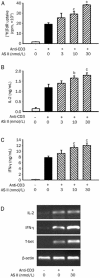Astragaloside II triggers T cell activation through regulation of CD45 protein tyrosine phosphatase activity
- PMID: 23524573
- PMCID: PMC4002795
- DOI: 10.1038/aps.2012.208
Astragaloside II triggers T cell activation through regulation of CD45 protein tyrosine phosphatase activity
Abstract
Aim: To investigate the immunomodulating activity of astragalosides, the active compounds from a traditional tonic herb Astragalus membranaceus Bge, and to explore the molecular mechanisms underlying the actions, focusing on CD45 protein tyrosine phosphatase (CD45 PTPase), which plays a critical role in T lymphocyte activation.
Methods: Primary splenocytes and T cells were prepared from mice. CD45 PTPase activity was assessed using a colorimetric assay. Cell proliferation was measured using a [(3)H]-thymidine incorporation assay. Cytokine proteins and mRNAs were examined with ELISA and RT-PCR, respectively. Activation markers, including CD25 and CD69, were analyzed using flow cytometry. Activation of LCK (Tyr505) was detected using Western blot analysis. Mice were injected with the immunosuppressant cyclophosphamide (CTX, 80 mg/kg), and administered astragaloside II (50 mg/kg).
Results: Astragaloside I, II, III, and IV concentration-dependently increased the CD45-mediated of pNPP/OMFP hydrolysis with the EC50 values ranged from 3.33 to 10.42 μg/mL. Astragaloside II (10 and 30 nmol/L) significantly enhanced the proliferation of primary splenocytes induced by ConA, alloantigen or anti-CD3. Astragaloside II (30 nmol/L) significantly increased IL-2 and IFN-γ secretion, upregulated the mRNA levels of IFN-γ and T-bet in primary splenocytes, and promoted CD25 and CD69 expression on primary CD4(+) T cells upon TCR stimulation. Furthermore, astragaloside II (100 nmol/L) promoted CD45-mediated dephosphorylation of LCK (Tyr505) in primary T cells, which could be blocked by a specific CD45 PTPase inhibitor. In CTX-induced immunosuppressed mice, oral administration of astragaloside II restored the proliferation of splenic T cells and the production of IFN-γ and IL-2. However, astragaloside II had no apparent effects on B cell proliferation.
Conclusion: Astragaloside II enhances T cell activation by regulating the activity of CD45 PTPase, which may explain why Astragalus membranaceus Bge is used as a tonic herb in treating immunosuppressive diseases.
Figures







References
-
- Bedir E, Calis I, Aquino R, Piacente S, Pizza C. Cycloartane triterpene glycosides from the roots of Astragalus brachypterus and Astragalus microcephalus. J Nat Prod. 1998;61:1469–72. - PubMed
-
- Yesilada E, Bedir E, Caliş I, Takaishi Y, Ohmoto Y. Effects of triterpene saponins from Astragalus species on in vitro cytokine release. J Ethnopharmacol. 2005;96:71–7. - PubMed
-
- Wang YP, Li XY, Song CQ, Hu ZB. Effect of astragaloside IV on T, B lymphocyte proliferation and peritoneal macrophage function in mice. Acta Pharmacol Sin. 2002;23:263–6. - PubMed
-
- Nalbantsoy A, Nesil T, Erden S, Calış I, Bedir E. Adjuvant effects of Astragalus saponins macrophyllosaponin B and astragaloside VII. J Ethnopharmacol. 2011;134:897–903. - PubMed
-
- Nalbantsoy A, Nesil T, Yılmaz-Dilsiz O, Aksu G, Khan S, Bedir E. Evaluation of the immunomodulatory properties in mice and in vitro anti-inflammatory activity of cycloartane type saponins from Astragalus species. J Ethnopharmacol. 2012;139:574–81. - PubMed
Publication types
MeSH terms
Substances
LinkOut - more resources
Full Text Sources
Other Literature Sources
Research Materials
Miscellaneous

